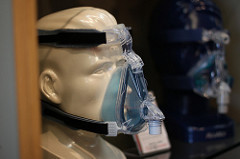
For the many sleep apnea patients choosing PAP therapy, health care providers depend on data from the machines to help understand how well the treatment is working. This kind of data, sometimes called "adherence" data, includes hours of mask usage per night, and also the amount of mask leak and "residual" AHI while wearing the mask. However, there is much more to the story of PAP success than these numbers. With more information – some from patients, some from physicians –we can work together to reap more rewards from our efforts to manage sleep apnea.
Recent research suggests that there are two new pieces of information that we should be considering for each patient:
Whether you wear your mask all or part of the time asleep, these topics may be helpful to improve your care. We are using the term "apnea burden" to describe this more complete picture of sleep: on-PAP and off-PAP.
Let's first consider the time sleeping with the mask on. Until recently, the field has relied upon the automated reporting of PAP machines, the "residual" AHI, to see how well the mask is working at controlling sleep apnea. We now understand that this AHI number may not be quite accurate for all patients. Recent research, by Dr. Robert Thomas1 from Beth Israel Deaconess Medical Center (Boston), suggests that sometimes the machine AHI is too optimistic: for some patients, more sleep apnea events are occurring than what is detected by the machine. One way to address this is to have the sleep doctor review the raw waveform data stored on the memory cards. This can be done with a freely available software program called "SleepyHead". Usually, at least a few weeks of waveform data is available to assess sleep on-PAP. Your doctor can use this data to assess how well the PAP machine's automated detection is catching events compared to visually evident pauses in the airflow waveforms. Although we are in the early phases of understanding this data, your physician may find other clues to suggest a pressure change is needed, or that an in-lab titration might be helpful.
Next, let's consider the time when a person is sleeping off-PAP. During this time, we don't have the benefit of machine data that we have while sleeping with the mask on. But, what happens during this time is important since many patients cannot manage to keep the mask on throughout all of sleep, every night. Think of a patient who sleeps 8 hours per night, and uses the mask 4 hours per night. This would be considered "100%" adherence (by the 4-hour rule). However, this pattern of mask usage means that only half of sleep was being treated with PAP. What happens during sleep in the other half? Research suggests that for many patients, the sleep apnea returns to the person's baseline severity during off-PAP sleep.2 Until we can routinely measure off-PAP sleep as part of the long-term care of sleep apnea patients, we can at least make an estimate of the situation for patients who use their mask part-time. For each individual, we can estimate the ‘apnea burden' (full night AHI) value if we know their average duration of sleep, average hours of mask use, and baseline severity of sleep apnea.
We created a simple web site to introduce the topics of evaluating on-PAP sleep using SleepyHead, and evaluating the apnea burden (including off-PAP sleep) using a simple calculator. Off-PAP sleep can also be measured using certain devices, such as the WatchPAT, as recent research has shown.2
We would love to know how patients view these issues...
Prior to reading this blog, had you thought about sleep apnea coming back when sleeping without the mask?
Would knowing how much your apnea came back during off-PAP sleep be helpful when you think about how you use your mask?
Prior to reading this blog, had you heard about PAP machines not capturing sleep apnea events in some cases?
Is machine-reported AHI a concern for you, having learned that research shows that the machine might not detect pauses in breathing as well as we hoped in some patients?
Share your thoughts on the forum.
This article was written by Dr Matt T. Bianchi, MD PhD, Assistant Professor of Neurology, Harvard Medical School, Assistant in Neurology, Department of Neurology, Director of the Sleep Division, Massachusetts General Hospital (www.mghsleep.com).
"comfortable mask at cpap central" by "Rachel Tayse" is licensed under CC BY-NC-ND 2.0.